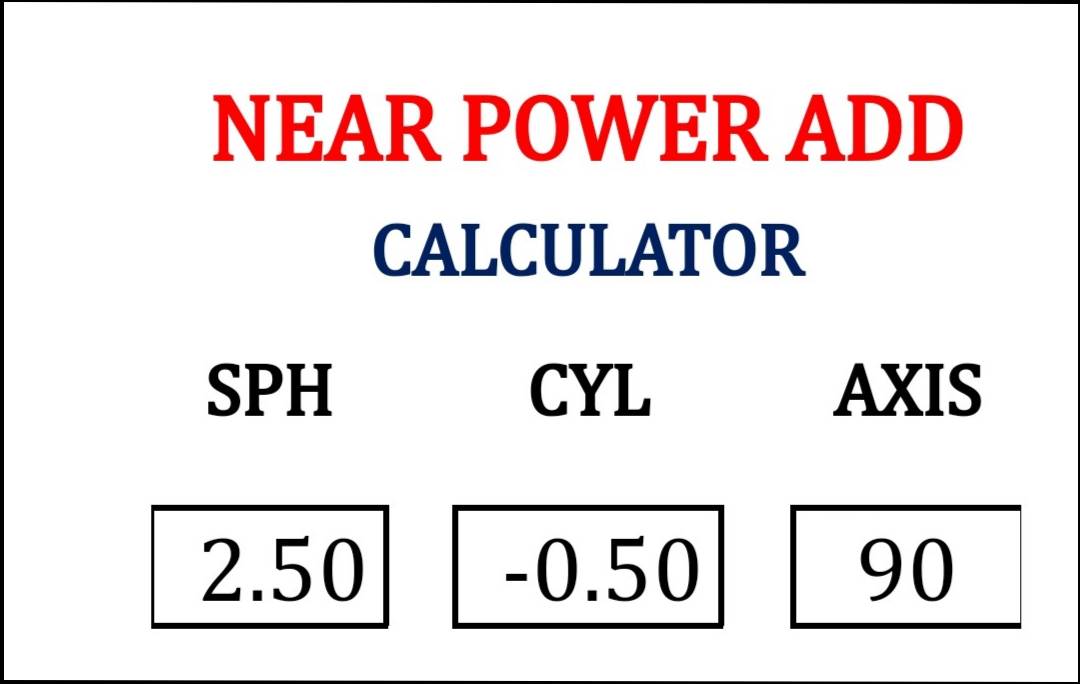Ophthalmic Near Power Addition Calculator Online
Ophthalmic Calculators
Ophthalmic Study Material
Ophthalmic Near Power Addition Calculator Online
Calculating Ophthalmic Near Power Addition: A Comprehensive Guide
As our eyes age, the ability to focus on objects up close diminishes—a phenomenon known as presbyopia. To address this issue, ophthalmologists often prescribe glasses with a near power addition to help patients see clearly at close distances. Calculating this near power addition requires a deep understanding of the patient's visual needs, the nature of their eye conditions, and the intricacies of ophthalmic prescriptions.
Understanding Near Power Addition:
Near power addition, also referred to as near addition or reading addition, is an additional power that is added to the distance prescription of a patient's eyeglasses to improve their close-up vision. It compensates for the loss of accommodation, which is the eye's ability to adjust its focus from distant objects to close ones.
Factors Affecting Near Power Addition:
1. Age:
Presbyopia typically becomes noticeable around the age of 40 and progresses over time. The age of the patient is a crucial factor in determining the near power addition.
2. Distance Prescription:
The patient's distance prescription is a significant starting point. It provides a baseline for determining how much additional power is needed for near vision tasks.
3. Working Distance:
The distance at which the patient performs close-up tasks, such as reading or using a computer, plays a role. The closer the working distance, the higher the near power addition required.
4. Binocularity:
Whether the patient is emmetropic (no refractive error) or has myopia, hyperopia, or astigmatism also affects the calculation. The patient's binocular vision needs to be accounted for.
5. Occupation and Lifestyle:
The patient's occupation and lifestyle can influence the near power addition. Someone who spends long hours reading or working on a computer may require a different addition than someone with more varied tasks.
Calculating Near Power Addition:
The near power addition can be calculated using various methods, including:
1. Age-Based Formulas:
These are simple formulas that provide a rough estimate of the near addition based on the patient's age. However, they may not be as accurate as other methods.
2. Eccentric Viewing Test:
This test measures the patient's best-corrected distance visual acuity while viewing a target off-center. It helps determine the additional power needed for near vision tasks.
3. Retinoscopy:
This technique involves shining a light into the patient's eye and observing the reflex. By performing retinoscopy at near and distance, the required power addition can be estimated.
4. Duochrome Test:
This test uses a special chart to assess the patient's subjective preference for certain lens powers. It aids in determining the near power addition.
Consulting an Eye Care Professional:
While these methods can provide a starting point for calculating the near power addition, it's important to note that accurate calculation requires the expertise of an eye care professional. Ophthalmologists and optometrists consider a combination of factors and conduct comprehensive examinations to ensure the near power addition is tailored to the patient's specific needs.
In conclusion, the ophthalmic near power addition calculator is a tool that aids eye care professionals in determining the appropriate extra power needed for close-up tasks. However, it's not a standalone solution; careful consideration of the patient's age, prescription, working distance, and other factors is essential for accurate calculations. This personalized approach ensures that patients can enjoy clear vision both at a distance and up close, enhancing their overall quality of life.


